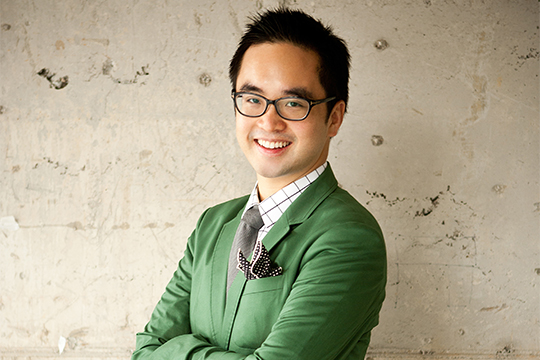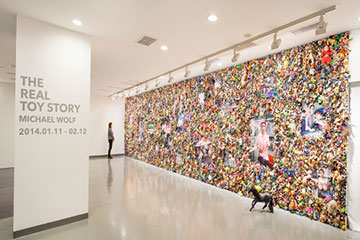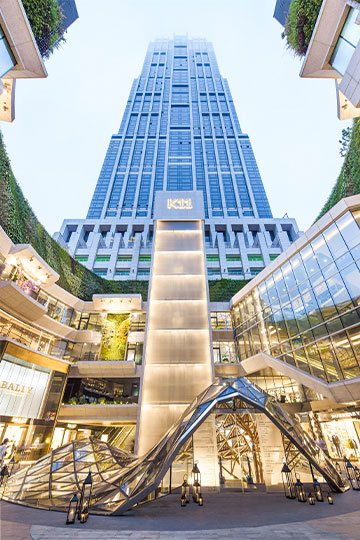REINVENTING THE SHOPPING MALL: THE K11 EXPERIMENT
| March 28, 2014 | Post In 2014年2月号
Over the past 20 years, James M. Bradburne has sat at the helm of various cultural institutions. From the interactive science center New Metropolis in Amsterdam to Europe’s first wireless museum Museum for Applied Art in Frankfurt, each has been unique in its own right. Currently, he directs the Palazzo Strozzi, Florence’s laboratory for cultural innovation. In terms of innovation, perhaps, these institutions find something of a parallel here in China, in the chain of art-themed shopping malls known as K11. LEAP arranged for Bradburne to meet with K11’s founder, the 34-year-old Harvard-educated Hong Kong-based entrepreneur Adrian Cheng.
JAMES BRADBURNE When I walked into K11, I did not expect what I saw. In the West—with the exception of a show in Frankfurt I co-curated with Murray Moss called “I Think Therefore I Shop,” which contaminated the museum environment with retail activities—shopping and museum-going are kept very separate. At K11, instead of contaminating the museum with shopping, you’ve done the reverse.
ADRIAN CHENG Yes.
JB Why? What was your motivation? That’s a very big step.
AC I have always been into art and the humanities. I studied at Harvard in Boston, and then I went to Japan to study the Japanese performing arts in Kyoto for a year. I then worked for an investment bank for three years. It was ridiculous. So there’s already a big contrast. But I’ve always been very lateral, so at the end of 2008, I started to think; I want to create a brand. K11 is a brand. And that brand is basically very simple. Two things: to groom contemporary Chinese artists and give them a platform and to educate the masses. So I set up an art foundation, where I built two Chinese artist villages that at the same time engaged the community and educated the masses. At the same time I started to think, you know, the retail world is also boring. We did a big survey with a lot of our customers. At that time, we had department stores with a ton of customers. We did a lot of research and asked them what they thought of the retail landscape. The conclusion was that it’s boring—it’s like a box where you have these brands, and the brands are the same. No personality, no soul in the entire space. Just space; no interaction, no experience. And then we realized that Chinese consumers, especially younger ones wanted something more spiritual than what was currently available. I just merged the two.
JB But the mix was there from the beginning? It wasn’t merely a response to the perceived failure of an existing commercial environment?
AC No, no, no. Hong Kong was the first project, and we wanted to create something from scratch, to create something that was wanted in the market landscape. So what we did at the end of 2009 was to create an art commerce kind of museum experience with art pieces and art tours and school tours and exhibition spaces as well as the brands. On the other hand the second project, Shanghai, is a response to both the boring retail landscape and to the failure of the mall, which was actually built in 1997. First we revolutionized the landscape of the market and then we tried to revamp and revolutionize the old failed mall. Before, there was nothing there. It was just a hole; an outdoor hole in the middle of the mall. When it rained, it rained. And you went shopping around the hole. It didn’t make sense.
JB What I noticed when I went was the different age groups. You’ve got workshops for younger kids with interactive experiences. You have an open kitchen and a cooking studio, for adults, which is absolutely extraordinary. I live in a world of boring museums. You live in a world of boring shopping centers. But does it really work? Is the business model sustainable?
AC We see the kids coming, and coming again. We are bringing people who may not like shopping, and we add more traffic to the mall. People come to look at the exhibitions, maybe take part in a workshop. They say “I don’t want to shop.” But most of the time they stay for two hours, then want to grab a cup of coffee. They keep coming. Eventually they become our shoppers too. Or it’s vice versa; some of the shoppers say “I don’t like exhibitions,” but when they go they want to know more, so they become artists’ audience members. And our rentals went up because the brands love it. We allocate a percentage of the additional rent to the art foundation, to groom Chinese artists for the shows in the commercial space. It’s a continuous cycle.
JB So you use the new value you create and take a chunk of that new value and invest it in the artistic part, yes?
AC Yes, and at this point, it becomes content, and it goes back and becomes a cycle.
JB How do you create the content for K11? A team or a single curator? Guest curators, team curation? How do you keep the integrity of your curatorial vision?
AC We have four teams. A central team, a Beijing team, a Shanghai team, a Hong Kong team. I have a vision of promoting young Chinese contemporary artists and new media and video installation arts. As long as you are following that direction, whether you hire the best or you invite them, it’s fine.
JB When you say “promote” what do you mean?
AC We are not selling the art or getting money. We give them space for free, and we believe in them. We host them and their exhibitions; we provide the production and logistical costs.
JB Is there any overall coordination? Do you go around and say, “This is OK?”
AC As the chairman of the foundation, the artists have to go through me. I have to approve everything. We have a team of artists, curators, and museum directors for each region, and the heads of the regions also have a committee to review what content they are producing.
JB But it’s outside the gallery model, so it’s independent from the art market.
AC Yes, it’s very independent. It’s not shaped by the market forces. We don’t like work just because the market likes it. Everyone is very independent because they’re just focused on the space.
JB You said you had two focuses: supporting young artists and educating the masses. Clearly contaminating the shopping mall is a great mass strategy. In Frankfurt, we discovered that Frankfurt’s biggest shopping center got more people in a day than the museum I ran got in a year—it made one feel extremely humble. But how do you continue to support young artists? Do you have scholarships, training? Do you go to the schools? How does your outreach go?
AC What we do is shows, seminars, artist’s talks, studios, a lot. For example, we have over 17 artist studios, and when you “graduate,” we do a group show for you, and if we think you are good then we put you on a list, which means we collect your pieces and connect you to museums. We nominate your name for museum collections. We do shows of your work in independent spaces and commercial spaces. We talk with curators. We promote you, in a sense.
JB And the cultural model is working, and the business model works. This is particularly important in Europe where museums are state supported, presumably here as well. But that this can also be driven by a retail shopping experience is exceptional.
AC Both worlds, commercial and non-commercial, combine seamlessly because it depends on content.
JB Walking around the mall in Shanghai, I didn’t see a single Chinese brand, which is OK for now, but in ten years I’m not convinced the Chinese market will stay dominated by European brands. How are you tracking the trends in the luxury brand world, which, given the inter-relationship between the cultural and the commercial, will affect the development of the project?
AC It really depends on the brand. If the brand is creative and also pursuing a creative approach, I think they will be OK for us. Because we are very contemporary, we need brands that are forward-thinking. The brands that are very digital are always very good with us, because our customers are very digital as well. Our customers are 24-45 years old. In China, people are evolving in a digital world.
JB Do you select tenants yourself?
AC I choose them myself, because the demographic is very important. Just treat the whole K11 experience like a show or an exhibition. Instead of curating artworks, I curate a brand. It’s very simple. So from the pieces, what do you experience? What do you feel in the five senses? What is the design; what are you going to see, touch, smell? What exhibitions and tenants are you going to put together? In my mind, it’s curatorial.
JB So when I go to a K11, wherever it is, is the expression of your curatorial vision.
AC Very true.
JB I’m even more impressed than when I went by myself! I’m twenty years older than you, and as an older master, I say, well done! You’ve done something extraordinary.
AC I’m OK, but I’m still improving. I’m still trying to make it better.




